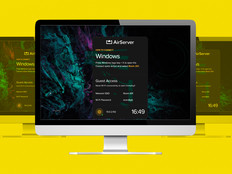Governments Deploy Interactive Audiovisual Technologies
The Westland (Michigan) City Hall previously sat in a 1960s concrete building where a hodgepodge of analog, consumer-grade audiovisual devices hampered citizen engagement. In the council chambers, an oddly placed projector displayed skewed images on an ancient pull-down screen. Council meetings were videotaped, and the tapes were then transported to another building for editing and broadcasting.
Renovating a former Circuit City into a modern, fully networked City Hall with two grand ballrooms and two executive conference rooms helped transform citizen and government interactions.
“Our goal was to engage visitors with dynamic, appealing digital media that would make them aware of city processes and help them take advantage of programs and opportunities,” says Westland Chief Innovation Officer Daniel J. Bourdeau.
Today, roadside digital signage and four 50-inch Sharp Electronics lobby displays broadcast public service, event, community awareness, volunteer and other city information. “We can develop very engaging content and push it from anywhere in City Hall to any or all displays in the lobby, ballrooms and conference rooms via a networked Crestron control system,” says Bourdeau.
The city of Westland finds itself in good company in tapping interactive audiovisual solutions to boost public engagement and disseminate information. Many cities and counties have equipped government buildings with equipment to inform the public and enhance participation in public meetings and other operations. Indeed, InfoComm International projects the market for advanced AV systems to grow from $91 billion in 2014 to $114 billion by 2016.
Percentage of citizens who have not attended a local public meeting in the past year, compared with
22%
who attended once a month or less and just
1%
who attended two to four times per month, or two times a week or more
SOURCE: National Research Center, 2015 National Citizen Survey
System Connects Constituents
A Crestron system sits at the heart of Westland’s interactive implementation and manages audio levels, routes television signals and handles nearly every other aspect of the media environment in the building, Bourdeau says. Users interact with the system via PCs, iPads, in-room touchpads and other devices. Media can be streamed from cable boxes, centralized digital media players, wireless clients or notebooks connected directly to one of the Crestron panels. A closed loop system rebroadcasts audio within council chambers in real time to adjustable audio devices for visitors with hearing problems.
When city council members wish to speak, they press a button on their microphone to signal the council president on his 10-inch touch-screen panel. The president can then use the panel to activate the member’s microphone as well as any relevant video displays. Each council member has a 7-inch high-definition display, while four 70-inch Sharp displays allow everyone in the chambers to see and hear the action.
Citizens can easily participate in proceedings and stream their presentations from any device by installing a small application. All presentations can also be replayed on local broadcast stations so people at home can see everything the council sees. When there’s an overflow crowd in council chambers, people in the lobby, ballroom or conference room can interact and present in the same manner as they would in the council chambers.
For those at home, meetings are digitally captured and streamed to local cable channels and online in half the time.
Installation went smoothly with help from a local integrator that equipment provider CDW recommended. “From the way they labeled and dressed each fiber or network cable to their attention to the finest detail in system programming and tuning, it was clear how fortunate we were to work with such a great local partner,” Bourdeau says.
Constituents and government officials alike benefit from the new deployment. “The entire legislative process has been transformed, thanks to this digital overhaul,” Bourdeau notes. “Meetings are more efficient, with much quicker results. Community events are world class and packed with technology, and rental rates cannot be touched by any other space in the region.”
Historic Building Houses Modern Gear
The city of Cambridge, Mass., operates from a three-story Richardsonian Romanesque building that’s more than 125 years old, yet boasts cutting-edge interactive technologies. Until recently, the council hall offered nothing but a few microphones, a portable screen and a projector cart. “The room was dark and huge, so any presentation looked like a little matchbox,” says Lee Gianetti, director of communications for Cambridge.
A 2014 renovation included a complete audiovisual, acoustic, lighting and mechanical overhaul, featuring new microphones, JBL speakers, a large projection screen, Panasonic projector, Panasonic HD cameras for cable television broadcast, closed captioning, assistive listening devices and an ADA ramp.
A Crestron controller offers touch-screen management of lighting, audio, camera, display and other sources. Citizens can plug in their own computers or flash drives to present material through the Crestron system or wirelessly via Crestron AirMedia.
Hard-wired and portable microphones allow anyone to participate in proceedings. Two 32-inch Sharp displays mounted on the balcony allow citizens to see and hear council meetings without craning their necks, while a 40-inch Samsung display in the lobby broadcasts everything going on inside the chamber. Two other conference rooms also have Sharp monitors, AirMedia and a Polycom video conferencing system.
“Now anyone can clearly see, hear and participate in presentations, including persons with disabilities and those at home,” Gianetti says. “It has generated much more meaningful dialogue and citizen engagement.”
County Collects Prize
Knox County, Ill., had the fortune to win more than $20,000 worth of interactive audiovisual equipment in a contest sponsored by CDW and the Center for Digital Government.
The gear includes 20 Samsung tablets, a Promethean interactive whiteboard, three Cisco Systems wireless access points, a Samsung large-format display, an Ergotron notebook cart and mounting arm, a Qwizdom electronic voting system with remote control voting devices and a Polycom IP phone.
Scott Erickson, county clerk, says department members use the tablets to access council meeting information and add their own documents and information, which they can access through a wireless LAN.
When a permanent council meeting space is allocated, Knox County will install the wireless access points and other network gear. The whiteboard will be used for presentations by departments and other citizens, and the conference phone will be used for smaller meetings with attorneys and others.
“Now, when a visitor comes to a county board meeting, they’ll be able to see everything the board members see, including visual voting, which will appear on the website as well,” Erickson says. “Instead of passing paper maps around the meeting room, we’ll be able to put GIS maps on the screen and demonstrate to everyone where new buildings will be placed or how new zoning changes will affect things.”
As does Cambridge, Knox County looks forward to enhanced citizen involvement, thanks to interactive audiovisual technology. “There’s no question that designing a system with the citizen in mind produces superior engagement,” says Gianetti.

Photo: MediaBakery









